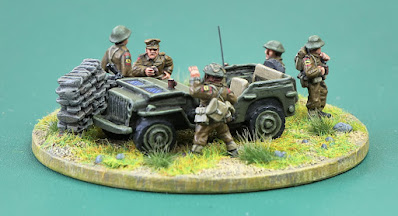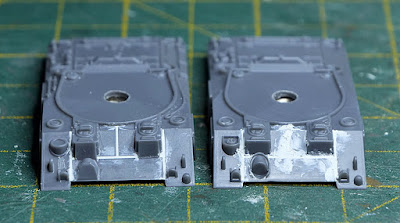These three PSC 15mm Shermans and Peter Pig tank commander complete my scaled down squadron of three troops of three tanks each plus an extra 75mm Sherman to represent the squadron HQ. I have a couple of PSC models left over and one Skytrex Sherman V painted in my earlier dry-brushing style. I'll probably complete these at some point to replace the bodged hybrid PSC/Skytrex model or give a fourth troop but that's a very low priority.
As I post this, I realise I have missed off the aerials, although the holes or all drilled ready so I'll have to add those at some point.
The painting technique is the same as with the previous ones - airbrushed with successively lighter shades of SCC15 with exaggerated contrasts and the details and final hi-lights by brush then brought together with a filter and pin wash, as described by Rubén Torregrosa on his Heresy Brush blog. However I skipped the chipping, streaking and mud stages as I wanted a cleaner look and feel that, at this small scale, it is easy to lose the detail and even the overall look of the vehicle.
Another difference was that I used Vallejo paints, with a base SCC15 mix of 1 part 888 Olive Grey to 1 part 924 Russian Uniform. My shade colour was the 1 part SCC15 mix to 1 part black and the airbrushed first hi-light 3 parts SCC15 to 1 part 976 Buff. The top (brushed) hi-light was roughly 1 part SCC15 to 1 part buff.
With a growing collection of vehicles finished, I needed somewhere to store them. My infantry are in the ubiquitous Really Useful Boxes, 4 litre size with two shallow MDF trays from Warbases. to save space. All my infantry bases are magnetised but I prefer vehicles, at least the larger ones, un-based needed some other solution to stop them moving about and getting damaged. My solution was to buy some 20mm upholstery foam from Dunelm. One £5 piece is enough for three boxes, which should be plenty for all my WW2 vehicle storage. I marked it up with a soft pencil and made the cuts with a new craft knife blade.
Actually 20mm was too thick - 1/2" or 15mm would have been perfect - but, despite looking for a long time, it was the best I could find without buying huge quantities. The main problem is that the gun barrels on tanks like the Firefly, that overhang the hull, sit lower than 20mm off the ground. My rather awkward solution was to cut the cutouts in half across their depth.





















































